The story of the Sumatran tiger is a very sad one. It is the beginning of the end of the road for this cat’s presence in the wild. The disappointing truth is that the experts don’t even know, through ineffectual estimates, the number of adult Sumatran tigers that are left on the planet. I say this with some confidence because the latest fact sheet from the experts charged with assessing the survivability of the world’s species, the IUCN Red List, states that there are 441-679 Sumatran tigers left but their latest estimate is dated 2007. Some of the estimates relating to certain national parks are dated 1994. This is almost 30 years out of date. And as tiger populations continue to decline year-on-year, it is almost certain that the numbers I have quoted above are seriously out of date. The numbers will be lower and you wonder if the Red List is deliberately avoiding the ghastly truth in order to appease the big commercial enterprises who are destroying the habitat and therefore destroying the tiger.
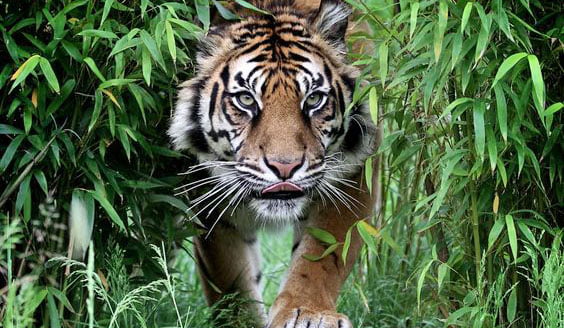
Threats to survival
There’s a list of threats further down the page as well. Let’s kick off with a story in the news today April 25th, 2022. Three Sumatran tigers were killed in traps near a palm oil plantation. Great. That sums it up. It is pretty clear that the organisation which owns the plantation set the traps. Business is killing the tiger in Sumatra. Here is the picture from Associated Press:

Every time I visit the Red List, I leave disappointed. Their semi-dormant website is indicative of a failure in conservation. They confirm that the population is decreasing and that the population is severely fragmented and under the heading “Population in detail” there is no information whatsoever!
And, as usual, the greatest threat to this cat’s existence is probably habitat loss (deforestation) and in this case it is carried out by one of the biggest logging companies in the world, based in Indonesia, Asia Pulp and Paper (APP).
This company, in league with the Indonesian government is probably responsible for the deaths of about 70% of all Sumatran tigers over the past 25 years. And the killing goes on unabated and nobody can stop it except the Indonesian government and there is no sign of that happening (see Deforestation in Indonesia (new window) – as at 10th June 2009).
Although the most important subjects are, in fact, deforestation and the tiger body parts trade, which makes it hard to talk about this tiger in a descriptive sense, I will try. Although, when this wild cat is all but extinct in the wild one asks, “what is the point”?”
In addition to logging, there is a continued expansion of oil palm plantations and planting of acacia plantations. There is also a legal trade and prey-based depletion. I don’t know what “illegal trade” means in this context because they don’t explain. They say that it is local. It seems that it means that tigers are sometimes poached, killed and part sold to China. That’s a guess.
Sumatran tiger – all photos in this batch of three and below are published under a Attribution-NonCommercial-NoDerivs creative commons License — this site is for charitable purposes in funding cat rescue. [by StuffEyeSee and elvis_payne – these links open in new windows]
Incidentally, an immediate negative consequence for both tiger and human is the increase in Sumatran tiger attacks as a result of dwindling forest: See Sumatran tiger attacks (new window). Both parties are forced together.
Description
The cat’s scientific name is: Panthera tigris sumatrae. The outstanding appearance is its undoing as people like to possess something or a part of something this beautiful (or eat it).
This wild cat was isolated from other tigers some 12 to 6,000 years ago because of rising sea levels. As a result, it can be classified as a separate species. Historically it is regarded as a subspecies of the tiger. It is distinguished as a separate species or subspecies through morphological (biology which deals with the structure of animals) and genetic tests.
It is the smallest of the tigers averaging 136 kgs (males) and 91 kgs (females). By way of a comparison the Bengal tiger weights 222 kgs (males) and 140 kgs (females). They are good swimmers with webbed feet. The stripes are narrower than for the other tigers. All individual tiger patterns are unique. This is being used to track tigers (new window).
IUCN Red List of Threatened Species™ (Red List) Assessment
Unsurprisingly, the classification is Critically Endangered (CR):
Critically Endangered is explained:
“Organisms with a conservation status of critically endangered have an extremely high risk of becoming extinct in the wild in the immediate future.”
I have intimated the basis for this assessment in the introduction. The following is a summary of what the Red List says:
- There is a low density of tigers. This means that relatively large areas are needed for the conservation of viable populations of the Sumatran tiger.
- The total effective population size is 40% of the total population. Effective population is the number of tigers able to reproduce tigers that survive to reproduce themselves.
- There are low “recruitment rates” (meaning low rate of creation of offspring raised to breed themselves). This also translates into the need for larger areas and larger populations, however;
- unfortunately, “many protected areas are too small to conserve viable tiger populations”. (note: the same problem exists in relation to the Kodkod in Chile and Argentina).
- Loss of prey is another threat probably in turn due to habitat loss as well and hunting.
- Decline in numbers.
- Habitat loss due to logging for paper and palm oil – biofuel (see Deforestation in Indonesia – Sumatra is in Indonesia – link opens in new window). This is the worse threat and a profound threat in my view. Logging of “protected” areas has taken place on a large scale.
- People to tiger conflict (due to habitat loss – see Sumatran tiger attacks – opens in new window).
- body parts trade (poaching).
Between 1998-2002 51 tigers were killed in the following proportions:
| % Tigers killed in human/tiger conflict | 15% |
| % tigers killed due to poaching for tiger body parts | 76% |
However, loss of tigers through logging (indirect killing it could be argued) is estimated at about 450 in the main area where APP operates, Riau province over the period 1982 – 2007 (src: WWF). This represents 70% of the tiger population of that area.
Tiger populations per reserve/area 2007 (src: Red List – new window) – note the wide range in the figures indicating to me that these are unreliable figures. Note these figures to the 2009 figures mentioned in the introduction:
Area | Population |
| Bukit Barisan Selatan National Park (NP) | 40-43 |
| Batang Gadis NP | 14-22 |
| Berbak NP | 50 |
| Kerinci Seblat NP | 145 |
| Gunung Leuser NP | 11-180 |
| Way Kambas NP | 36 |
| Bukit Tigapulu TCL | 46-203 |
| Total | 441-679 |
Range, Habitat and Ecology
Found exclusively on the Indonesian island of Sumatra:
Map reproduced published under Wikimedia® creative commons license = Attribution-ShareAlike License.
The Sumatran tiger prey is:
- wild boar
- tapir
- deer
- fowl
- fish
- Orang-utans potentially
Threats and Conservation
These are mentioned above. Significantly the Red List does not list any conservation programs. And a search of the CITES website produced no record of a listing for this species. Is that correct? The Red List website does not say that it is listed in CITES either. This is very strange considering the open trade in body parts. Perhaps this species is considered a subspecies of tiger by CITES.
It is one way traffic downhill for the Sumatran tiger due to commercial exploitation of the tiger itself and the habitat it lives in. It is exclusively down to the Indonesian government to change things.
![]()

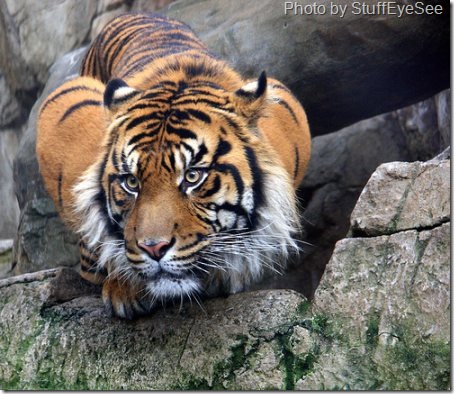
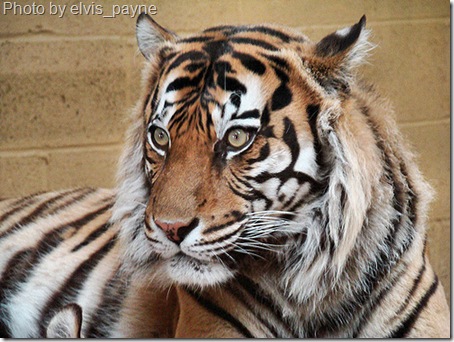

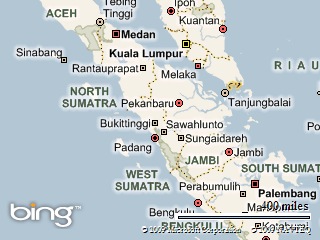
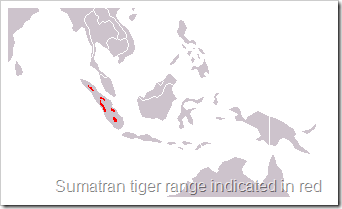


Comments are closed.